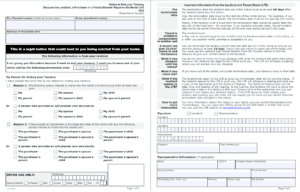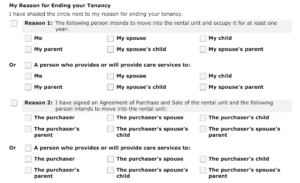For our audio-visual learners, here’s a 5-minute video on How to Serve an N12 form in Ontario.
Table of Contents
Understanding the N12 Form: A Guide for Ontario Landlords
Welcome to another blog of Property Hustlers! We’ll focus on the N12 form for this article. The form is a critical document for landlords in Ontario, allowing them to evict or terminate a tenancy for personal use or sale. This blog will dive into the details of the form, explaining its purpose, requirements, and potential complications.

What is the N12 Form?
The N12 form is relatively straightforward in appearance, offering only a few selectable options. It is primarily used by landlords who intend to reclaim their property either for personal use or as a stipulation of a sale agreement.
Download a form here: N12 Form LTB Ontario
Filling Out the N12 Form
When completing the form, landlords must accurately provide their names, the tenants’ names, and the property address. The termination date is crucial and cannot be earlier than two full rental periods if the tenant is on a month-to-month lease.


Declaration of Intent
The form requires landlords to declare their intention clearly:
Personal Use: The property is needed for the landlord’s use or a family member’s use for at least one year.
Sale of Property: The property has been sold under a purchase and sale agreement that requires the buyer or their family to occupy the property for a minimum of one year.

Legal Stipulations and Rights
Upon serving the form, landlords agree to either relocate the tenant to a comparable residence or compensate them with one month’s rent by the notice’s termination date. However, it’s essential to note that:
- The form cannot be used to end a tenancy prematurely, i.e., before the lease term concludes.
- The form is invalid if the intent to sell does not involve the buyer taking possession.
If tenants decide to move out early, they can serve a 10-day notice using an N9 form.
When Things Go Wrong
Even when used correctly, the N12 form can lead to disputes, especially if tenants are reluctant to vacate the property. In such cases, landlords might need to file an L2 form and pay a $201 filing fee to seek eviction through the Landlord and Tenant Board (LTB).
Cases of Bad Faith and the Role of the T5 Form
The misuse of the N12 form can lead to serious legal repercussions under accusations of bad faith, particularly if a landlord or their family member does not actually move into the property after eviction or if the property is subsequently re-rented or sold for a higher price. This can result in the evicted tenant filing a T5 form, which is used to allege that the landlord terminated the tenancy in bad faith.
Example Cases Involving Bad Faith
- In one notable case, a landlord evicted a tenant for personal use but later renovated and sold the property. When the case went to trial, the tenant argued that the landlord had never intended to move in. The adjudicator ruled that the landlord acted in bad faith and ordered them to compensate the tenant, which included a significant sum covering the difference in rent at a new location and some moving expenses.
- Another scenario involved a buyer who took over a property with the intention declared of personal use, only to rent it out after making minor improvements. Although the previous landlord, who served the N12 on behalf of the new owner, was not found liable, the new owner was directed to compensate the former tenant due to bad faith.
Good Faith and Successful Defense in N12 Cases
While there are many cases where landlords have been found in bad faith, there are also instances where landlords successfully defend their actions by proving their good faith intentions:
- One case highlighted a landlord who initially intended to move into the property due to a nearby job opportunity. However, circumstances changed when the landlord received a better job offer elsewhere. Upon the tenant’s departure, the landlord, unable to move in, reached out to offer the property back to the former tenant. Although the tenant was unable to return, the landlord’s proactive approach and documentation of their initial and changed intentions helped prove their good faith at the hearing. The adjudicator ruled in favor of the landlord, emphasizing that individuals’ circumstances can change and acknowledging the landlord’s attempt to rectify the situation by offering the property back to the tenant.
How the T5 Form Plays a Role
The T5 form is a crucial document for tenants who believe they have been evicted under false pretenses. By filing this form, tenants can seek compensation and justice if it is proven that the landlord did not follow through with the stated intentions for eviction as required by the N12 notice. The repercussions for landlords found guilty of bad faith include not only financial damages but also a potential loss of reputation and trustworthiness in the housing market.
By being transparent and honest in their intentions when serving an N12, landlords can avoid the pitfalls of bad faith claims and ensure fair treatment for themselves and their tenants. This approach not only adheres to legal standards but also promotes a positive and ethical rental environment.
Best Practices for Using the N12 Form
For landlords, transparency and honesty are key to using the form effectively. If the intent is to sell the property, it is advisable to use an N11 form and negotiate a “cash for keys” agreement, avoiding the potential pitfalls of bad faith claims.
By understanding and respecting the legal framework surrounding the N12 form, landlords can navigate the complexities of property management while maintaining ethical standards and fostering good tenant relationships.
Download a form here: N12 Form LTB Ontario
Start Your Investing Journey
Are you interested in real estate investing? Are you struggling with the high barriers to entry to the Canadian real estate market? Join us now and see how we can help you acquire your first US real estate deal in the next 45 days!
Fill out the application form below and take the first step towards expanding your investment portfolio across the border.




